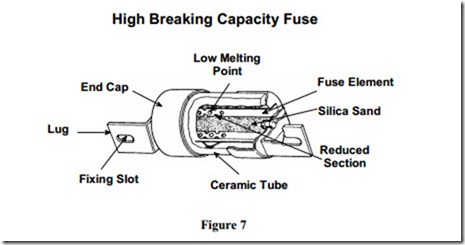High-Breaking-Capacity Fuses
High Breaking Capacity ( HBC ) fuses are suitable for industrial installations and motor starting circuits. They can distinguish between a starting surge and a short circuit. Their operating characteristics are such that they can disconnect short circuits much more rapidly than any other protective device. For example the HBC fuse can clear a high fault current in 0.01 seconds, while the mechanism of a circuit breaker could take 0.1 seconds to operate.
This type of fuse is also known as a High-Rupturing-Capacity ( HRC ) fuse. Its fuse element is enclosed in a robust cartridge of heatproof material. The cartridge is packed with chemically treated silica sand to quench the arc which occurs as the fuse element ruptures. This ensures that there is no fire risk. They do not deteriorate with age.
The construction of a typical HBC fuse is shown in Figure 7.
The barrel of the HBC fuse is made from high grade ceramic to withstand the mechanical forces of heavy current interruption.
The end caps ( tags ) are plated thus ensuring good electrical contact.
The fuse element is accurately shaped and machined to give precise characteristics. Most HBC fuses are fitted with indicator beads, which show when it has ruptured.
Disadvantages of HBC Fuses
· Expensive.
Advantages of HBC Fuses
· Discriminate between overload currents of short duration, ( e.g. motor starting ) and high fault currents ( short circuits ).
· Consistent in operation.
· Reliable.
· Do not deteriorate with age.
· Speed of operation.
· Fusing factor as low as 1.25.
· No fire risk.
· Capable of breaking very high value fault currents.
· Are easy to replace.
· Are available in a wide range of current ratings.
Type C MCB
The characteristic of the type C MCB is such that it provides protection of cables supplying loads with relatively high switching surges e.g. electric motors and discharge lamps.
Overload protection is provided by a thermal tripping device.
Short circuit protection and high value over-current protection is provided by a magnetic tripping device.
Type C characteristic stipulates that the MCB must trip magnetically between 5 and 10 times the rated current of the MCB, and it must trip thermally between 1.13 and 1.45 times its rated current.
Example of 20 Amp Type C Characteristic
Short Circuit Protection and high value over-current protection ( Magnetic )
From this example it can be seen that a Type C must operate between 22.6 and 29 Amps after a time delay.
Type C – MCB’s are available in different current ratings and breaking capacities to suit a particular installation.

